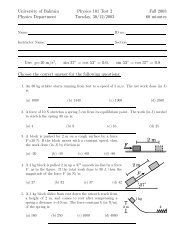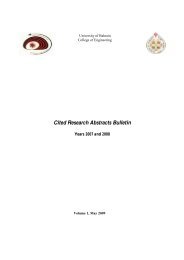Video gaming and interconnected meanings: Nuanced learning ...
Video gaming and interconnected meanings: Nuanced learning ...
Video gaming and interconnected meanings: Nuanced learning ...
Create successful ePaper yourself
Turn your PDF publications into a flip-book with our unique Google optimized e-Paper software.
Int. Rev. Cont. Lear. Res. 1, No. 1, 1-7 (2012)<br />
1<br />
<strong>Video</strong> <strong>gaming</strong> <strong>and</strong> <strong>interconnected</strong> <strong>meanings</strong>: <strong>Nuanced</strong> <strong>learning</strong><br />
beyond the screen<br />
S<strong>and</strong>ra Schamroth Abrams<br />
Department of Curriculum & Instruction DaSilva Academic Center, St. John’s University, Queens, New York, USA<br />
Email Address: abramss@stjohns.edu<br />
Received: 1 Jan. 2012, Revised 21 Mar. 2012; Accepted 03 Aug. 2012<br />
International Review of Contemporary Learning Research<br />
An International Journal<br />
@ 2012 UOB<br />
CSP, University of Bahrain<br />
Abstract: Digital <strong>learning</strong> <strong>and</strong> twenty-first century literacies have been the topics of contemporary conversations about<br />
teaching <strong>and</strong> <strong>learning</strong>. This recognition of digital literacies is essential to their supported inclusion within the classroom,<br />
but such inclusion does not automatically innovate practice. A closer examination of ways that students learn from the<br />
confluence of digital resources will begin to provide insight into how students almost seamlessly draw upon a variety of<br />
media <strong>and</strong> affinity-based <strong>learning</strong> to help them achieve a particular goal. This article focuses on how the interconnection of<br />
practices nurtures experimentation <strong>and</strong> engagement that nourish students‟ video game <strong>learning</strong>; such a focus supports a<br />
nuanced exploration of student <strong>learning</strong> outside the classroom <strong>and</strong> provides insight into the dynamic use of digital practices<br />
inside the classroom.<br />
Keywords: <strong>Video</strong> <strong>gaming</strong> <strong>and</strong> <strong>interconnected</strong> <strong>meanings</strong><br />
1 Introduction<br />
Digital <strong>learning</strong> <strong>and</strong> twenty-first century literacies have been the topics of contemporary conversations<br />
about teaching <strong>and</strong> <strong>learning</strong> (Alvermann, 2010; Gee, 2007a, 2007b; Gutierrez, 2006; Kajder, 2010). The<br />
growing sentiment in the US <strong>and</strong> abroad—from pedagogy to policy— has been that digital literacies are<br />
present <strong>and</strong> future practices that need to be embraced <strong>and</strong> integrated into classroom <strong>learning</strong> <strong>and</strong> curricula<br />
(Alliance for Excellent Education, 2012; DCMS & BIS, 2009; ICTC, 2011; IRA, 2009; Knobel &<br />
Lankshear, 2010; NCTE Position Statement, 2008). This recognition of digital literacies is essential to<br />
their supported inclusion within the classroom, but such inclusion does not automatically innovate practice<br />
(Abrams & Merchant, in press). A closer examination of ways that students learn from the confluence of<br />
digital resources will begin to provide insight into how students almost seamlessly draw upon a variety of<br />
media <strong>and</strong> affinity-based <strong>learning</strong> (Gee & Hayes, 2011) to help them achieve a particular goal. More<br />
specifically, this article focuses on how the interconnection of practices nurtures experimentation <strong>and</strong><br />
engagement that nourish students‟ video game <strong>learning</strong>; such a focus supports a nuanced exploration of<br />
student <strong>learning</strong> outside the classroom <strong>and</strong> provides insight into the dynamic use of digital practices inside<br />
the classroom.<br />
Subsumed under the digital literacies umbrella, video <strong>gaming</strong> is a motivating, knowledge building tool that<br />
has engaging features <strong>and</strong> fosters active <strong>learning</strong> (Abrams, 2009, 2012; Gee, 2007a, 2007b, 2011; O‟Brien<br />
& Scharber, 2008; Salen & Zimmerman, 2004; Squire, 2008, 2012; Steinkuehler, 2011). The multi-billion<br />
dollar <strong>gaming</strong> industry, with spending expected to reach $112 billion by 2015 (Bilton, 2011), is a viable<br />
<strong>and</strong> burgeoning business that continues to excel because video games sustain user interest. A reported “97<br />
percent of youth play computer <strong>and</strong> video games” (McGonigal, 2011, p. 11), <strong>and</strong> it behooves us as<br />
educators <strong>and</strong> researchers to consider not only what knowledge students develop within a game, but also<br />
what knowledge informs game play. Insight into the latter will illuminate ways that students draw upon<br />
<strong>and</strong> connect their diverse literacy practices to discover new underst<strong>and</strong>ings.<br />
This article highlights data from several video game related studies conducted between 2009 <strong>and</strong> 2012,<br />
which provide insight into adolescent <strong>gaming</strong> <strong>and</strong> <strong>learning</strong> <strong>and</strong> the ways that diverse literacies work in<br />
concert to inform students‟ game play. In digital worlds, “knowledge is socially constructed <strong>and</strong> mediated<br />
E-mail: abramss@stjohns.edu
S<strong>and</strong>ra Schamroth: <strong>Video</strong> <strong>gaming</strong>: <strong>Nuanced</strong> <strong>learning</strong> …<br />
2<br />
by the learners rather than simply absorbed unchanged from the expert” (Carrington & Robinson, 2010, p.<br />
5), <strong>and</strong>, therefore, it is important to investigate students‟ developing skills <strong>and</strong> knowledge sets that can<br />
enrich performances inside <strong>and</strong> outside the classroom.<br />
Gamification<br />
Though <strong>gaming</strong>-as-<strong>learning</strong> is an established principle, gamified <strong>learning</strong> has become the hallmark of<br />
edutainment <strong>and</strong> business training. Gamification—or “the process of using game thinking <strong>and</strong> game<br />
mechanics to engage audiences <strong>and</strong> solve problems” — is a buzz word infiltrating industries beyond the<br />
video game sector (Graham, 2012). Even iCivics.com, a non-profit organization supported by retired US<br />
Supreme Court Justice S<strong>and</strong>ra Day O‟Connor, has released an online game, Counties Work, as a way to<br />
increase <strong>and</strong> spur citizens‟ civic knowledge <strong>and</strong> involvement (iCivics.com, nd; Sasso, 2012). Gamified<br />
<strong>learning</strong> is inherently about “engagement, story, autonomy, <strong>and</strong> meaning” (Kapp, 2012, p. xxi), <strong>and</strong> these<br />
features appear to support the integration of context specific information to achieve an overall goal.<br />
Though gamification has been linked to video games <strong>and</strong> their inspirational elements, there is a distinction<br />
between video games, or „serious games,‟ <strong>and</strong> „gamification‟ (Kapp, 2012). More specifically, Kapp<br />
identifies the two by domain <strong>and</strong> directionality: Serious games are those relegated to a pre-designed game<br />
space whereas gamification “tends to take the use of a game outside of a defined space <strong>and</strong> apply the<br />
concept” to other non-virtual domains (p. 15). In other words, serious games are relegated to the console<br />
<strong>and</strong> virtual space, <strong>and</strong> all action occurs within that space (e.g., World of Warcraft players only playing the<br />
game <strong>and</strong> collaborating with their clans to kill beasts within the WOW design space). However,<br />
gamification involves the application of game or game elements to settings not preset by game designers;<br />
this includes the extension into non-virtual settings. Though the current educational system of points,<br />
tests, <strong>and</strong> grades doesn‟t automatically gamify education, the motivation <strong>and</strong> engagement of games can be<br />
applied to academics (Smith-Robbins, 2011). Based on these insights, gamification <strong>and</strong> the application of<br />
information come to the fore when we consider digital literacies in relation to video game <strong>learning</strong> <strong>and</strong><br />
classroom applications. More specifically, if we can better underst<strong>and</strong> ways students are making crossliterate<br />
connections outside school, then we can help them achieve similar links among their diverse<br />
practices <strong>and</strong> academics inside school.<br />
Building a Knowledge Network<br />
In order to explore how knowledge of one practice informs the other, it is essential to consider students‟<br />
“funds of knowledge” (Gonzalez, Moll, & Amanti, 2005; Moll, Amanti, Neff, & Gonzalez, 1992; Rowsell,<br />
2006), or “historically accumulated <strong>and</strong> culturally developed bodies of knowledge <strong>and</strong> skills” (Moll et al.,<br />
1992, p. 133). Particularly important to this discussion of <strong>gaming</strong> <strong>and</strong> <strong>learning</strong> is how the integration of<br />
digital experiences is part of students‟ funds of knowledge outside the classroom <strong>and</strong> the extent to which<br />
contemporary classrooms <strong>and</strong> influential requirements afford or limit the space for these funds of<br />
knowledge to emerge within the classroom.<br />
Given that video games typically endorse experimentation <strong>and</strong> collaboration (Abrams, 2010; Gee, 2007a,<br />
2007b; Steinkuehler, 2007) <strong>and</strong> gamification includes working with others in cooperative <strong>and</strong>/or<br />
competitive situations (Smith-Robbins, 2011), then many gamers may be accustomed to <strong>learning</strong>-by-doing<br />
<strong>and</strong> working with others. Gamers‟ funds of knowledge, therefore may include interacting with others <strong>and</strong><br />
sharing knowledge (Abrams, 2010; Abrams, Gerber & Burgess, 2012; Gee, 2007a, 2007b), <strong>and</strong> these<br />
practices are supported in online game forums, competitions, <strong>and</strong> informal conversations. Interestingly,<br />
such collaboration is also an essential component to K-12 classrooms, where dyads, triads, or larger group<br />
work has become a mainstay of contemporary curricula; US Common Core State St<strong>and</strong>ards (2010)<br />
m<strong>and</strong>ate peer collaboration:<br />
Students must learn to work together, express <strong>and</strong> listen carefully to ideas, integrate information from oral,<br />
visual, quantitative, <strong>and</strong> media sources, evaluate what they hear, use media <strong>and</strong> visual displays<br />
strategically to help achieve communicative purposes, <strong>and</strong> adapt speech to context <strong>and</strong> task (p. 8).<br />
Therefore, working with others to solve a problem or complete a task may, in fact, be a <strong>learning</strong> approach<br />
that students are accustomed to both inside <strong>and</strong> outside school. Though this may be one way to loosely<br />
connect out-of-school literacies, such as video <strong>gaming</strong>, with academic practices, there are other ways in
3 S<strong>and</strong>ra Schamroth: <strong>Video</strong> <strong>gaming</strong>: <strong>Nuanced</strong> <strong>learning</strong> …<br />
which we see students using their funds of knowledge to inform their practice in <strong>and</strong> out of school <strong>and</strong> in<br />
<strong>and</strong> out of <strong>gaming</strong>. The application of knowledge <strong>and</strong> techniques across place-based <strong>and</strong> virtual settings<br />
reveals ways students establish connections between their video <strong>gaming</strong> <strong>and</strong> other literate activities.<br />
Further, when considering how students develop <strong>and</strong> apply their funds of knowledge, one needs to account<br />
for “passionate affinity-based <strong>learning</strong>” (Gee & Hayes, 2011), which “occurs when people organize<br />
themselves in the real world <strong>and</strong>/or via the Internet (or a virtual world) to learn something connected to a<br />
shared endeavor, interest, or passion” (p. 69). The knowledge <strong>and</strong> skills developed in passionate affinity<br />
spaces—which include the game space—involve <strong>learning</strong> in conjunction with others <strong>and</strong> the mediation of<br />
space-specific information, often reaching new underst<strong>and</strong>ings through the collaboration (Gee & Hayes,<br />
2011). Both the discussion of game play <strong>and</strong> the collaboration within game play are key components to<br />
belonging to that particular affinity space <strong>and</strong> video game community (Abrams, 2010; Gee, 2007a, 2007b;<br />
Selfe, Mareck, & Gardiner, 2007). The funds of knowledge students access <strong>and</strong>/or hone in these affinity<br />
spaces (Gee, 2004) can mediate students‟ situated practices, enable students to reach new discoveries <strong>and</strong><br />
<strong>meanings</strong> (Davies, 2006), <strong>and</strong> inform students‟ underst<strong>and</strong>ings in other spaces as well.<br />
Confluence of <strong>Nuanced</strong> Knowledge <strong>and</strong> Choices:<br />
How the Students Apply their Underst<strong>and</strong>ings<br />
Examining how students apply their established underst<strong>and</strong>ings <strong>and</strong> skills across their literacy practices<br />
provides insight into the innovative <strong>learning</strong> <strong>and</strong> decision making students appear to do on their own<br />
volition. Qualitative data from two separate studies of <strong>gaming</strong> <strong>and</strong> <strong>learning</strong> provide data that speak to such<br />
knowledge application within <strong>and</strong> across affinity spaces. The following stories of J.D., Lyle, Garrett, <strong>and</strong><br />
James (all names are pseudonyms) illuminate how their multimodal literacy experiences mediate their<br />
overall <strong>learning</strong> both on <strong>and</strong> off the screen.<br />
Literacies Informing Game Play<br />
In 2009, within the course of an eight-month study, I shadowed <strong>and</strong> interviewed J.D. to learn about his<br />
literate activities in <strong>and</strong> out of school. In addition to discovering J.D.‟s collaboration with friends <strong>learning</strong><br />
<strong>and</strong> playing video games (Abrams, 2010), I also found that J.D. relied upon his knowledge of paintball to<br />
help him participate <strong>and</strong> succeed in playing first-person shooter game, Call of Duty. Although J.D. had not<br />
played Call of Duty in the past, he was an avid paintball player who had competed in tournaments <strong>and</strong><br />
even filmed his paintball games. J.D. drew upon his paintball strategies from one affinity space to help him<br />
navigate through the virtual shooter game <strong>and</strong> participate with his friends in another affinity space (the<br />
game). J.D. explained how his paintball <strong>and</strong> his video game playing were somewhat related: “There‟s a<br />
map that we play in Call of Duty <strong>and</strong> it‟s just set up, <strong>and</strong> every time I play it, I think of how I play<br />
paintball. And that‟s how I play the game <strong>and</strong> vice-versa.”<br />
Conceptually, paintball provided J.D. a framework for strategizing, collaborating <strong>and</strong> shooting targets.<br />
J.D. also gained a firm knowledge of the language, behavior, values <strong>and</strong> moves associated with paintball<br />
that he tried, unsuccessfully, to apply to his Call of Duty scenarios, using paintball terminology to<br />
strategize with his virtual teammates:<br />
In paintball, it‟s just out of habit like you „lane‟ to let somebody go. So someone was next to me [in Call of<br />
Duty], <strong>and</strong> I said, “Lane to the right,” <strong>and</strong> they didn‟t know what that meant. They thought it meant—They<br />
ran right, <strong>and</strong> I was like no you got to run over there. Or I mean you have to shoot over there. So I like by<br />
accident, you know, I‟d say things just because you‟re shooting, they‟re shooting at something else. And I<br />
wanted, I could have easily said, “Just cover me. There‟s someone shooting at me over there so I can‟t<br />
move.” But once I said, “Lane in,” because it means the same thing.<br />
Though J.D. may have recognized similar gamified principles across the real <strong>and</strong> virtual games, J.D.<br />
quickly learned that he could not use paintball terminology because none of his friends understood his<br />
directions; paintball <strong>and</strong> Call of Duty were part of different affinity spaces with different Discourses (Gee,<br />
2008, 2011), or being-valuing-doing combinations. What‟s important, though, is that J.D. recognized<br />
similar characteristics across the games, <strong>and</strong> he was able to apply knowledge from one practice (paintball)<br />
to another (playing a video game); the application of his funds of knowledge helped him conceptualize the
S<strong>and</strong>ra Schamroth: <strong>Video</strong> <strong>gaming</strong>: <strong>Nuanced</strong> <strong>learning</strong> …<br />
4<br />
practice (in this case strategizing <strong>and</strong> aiming). However, the particular connection J.D. attempted to<br />
communicate was limited only to those who have the Discourse-specific information <strong>and</strong> language.<br />
Literacies, choices, <strong>and</strong> game play<br />
Just as J.D. envisioned the extension of knowledge from one domain to another, so, too, do we see the<br />
connections between students‟ areas of interests <strong>and</strong> their video game choices. Research indicates that<br />
students who gravitate toward a particular sport often will look to play virtual versions of that activity<br />
(Crawford, 2005; Malliet, 2006). This passion for a sport or activity, however, also seems to feed into<br />
one‟s underst<strong>and</strong>ing of a game <strong>and</strong> one‟s ability to draw upon real-world events to inform game play. For<br />
example, a 13-year-old participant in my 14-month ethnographic study on <strong>gaming</strong> in a library, noted how<br />
he would choose basketball teams to play on his Playstation according to who was playing that evening on<br />
live television. Lyle had noted that “I like to play what games are on right now…whatever sport is being<br />
played at that time,” <strong>and</strong> his choice of virtual sport mirrored that of the season: “Like in the fall, I like to<br />
play [American] football games. Now I‟m playing like basketball games <strong>and</strong> stuff. And like in the spring I<br />
play baseball games.”<br />
Because contemporary video games feature virtual players who perform according to their real<br />
counterpart‟s recorded statistics, Lyle was able to make virtual choices based on real-time events. For<br />
instance, Lyle explained that he “made a bracket tournament,” which he downloaded from<br />
CBSSports.com, for college basketball, <strong>and</strong> he used his phone <strong>and</strong> computer to access the latest scores to<br />
keep the bracket current. He applied principles <strong>and</strong> literacies from one game/practice to another. At the<br />
time I interview Lyle, he told me that “for the tournament, I picked Kansas to win. So I was, so like I was<br />
updating the score on my phone to see who won.” Based on the outcome, Lyle selected virtual team<br />
competitions that mirrored the next set of college teams lined up to play in reality. He drew upon his<br />
knowledge of a real affinity space <strong>and</strong> applied it to a virtual one.<br />
In addition to making decisions based on the tournament bracket <strong>and</strong> knowledge of baseball, Lyle, a selfproclaimed<br />
Yankees fan, also made choices based on real-time actions of his favorite players, knowing<br />
well that the video game would enable him to make such replications. Lyle explained that he would watch<br />
to “see how CC Sabathia catches <strong>and</strong> how Derek Jeter like, how he hits— so in this game it‟s like the same<br />
thing. And Derek Jeter‟s swing is the same.” Lyle‟s funds of knowledge for baseball (also evidenced in<br />
his f<strong>and</strong>om), along with his knowledge of current baseball statistics <strong>and</strong> real-time team performance,<br />
informed his video game decisions <strong>and</strong> game play. Further, when Lyle decided to play games that didn‟t<br />
correspond with real-time events, he would rely on his knowledge of team <strong>and</strong> player statistics to help him<br />
choose which team to play: “Like if I want a team that‟s athletic, I know which teams to pick like USC are<br />
really athletic but they‟re not a good shooting team. But Purdue which is a good shooting team, I want<br />
them if I want to be, if I want to have a team that can shoot three pointers.”<br />
What‟s more, Lyle perceived the direct relationship between his television viewership <strong>and</strong> his video game<br />
playing. Lyle explained how the 2010 Olympics inspired him to take up a new virtual sport, hockey, back<br />
in winter, 2010:<br />
Well first of all I saw the Olympics, <strong>and</strong> like I never really liked hockey but when I saw that I thought that<br />
it was really good so I was playing this Team USA <strong>and</strong> I kind of felt like I was playing with them so…. it‟s<br />
just who I was rooting for at the Olympics <strong>and</strong> I mean when I started playing NHL teams, I don‟t really<br />
like a particular team because I don‟t love hockey, but I just play with like different teams but when I play<br />
with countries, I play with Team USA…because like I‟m American.<br />
Though Lyle didn‟t “love hockey,” he established a personal connection between Olympic hockey games<br />
<strong>and</strong> the virtual ones. He chose the USA team because he related to it: “because like I‟m American.” Lyle<br />
recognized similarities across activities from one affinity space (that of a sports spectator <strong>and</strong> fan) <strong>and</strong><br />
another set of practices of an affinity space (that of a sports virtual gamer).
5 S<strong>and</strong>ra Schamroth: <strong>Video</strong> <strong>gaming</strong>: <strong>Nuanced</strong> <strong>learning</strong> …<br />
Like 13-year-old Lyle, 17-year-old Garret occasionally spoke of how he adopted moves he had seen on<br />
television to play Call of Duty. One time Garret had been “watching the History Channel…like they have<br />
like World War II stuff, <strong>and</strong> during that game [Call of Duty], like I‟ll, oh yeah, I saw this on TV. You do<br />
this <strong>and</strong> that like if you go into a room, throw a grenade in it, I saw that on TV. Just did the same thing” in<br />
Call of Duty. In other words, Garret learned a “general idea about war <strong>and</strong> like tactics” from the History<br />
Channel <strong>and</strong> applied that knowledge to his video game play. As a result, Garret understood the context for<br />
specific military action, <strong>and</strong> when he viewed the situation to be similar to what the History Channel<br />
featured, he implemented the established strategy into his video game play.<br />
These exemplars reveal the fascinating nature of the students‟ network of literacies <strong>and</strong> their application of<br />
knowledge from one context to another; students built upon their funds of knowledge <strong>and</strong> their<br />
underst<strong>and</strong>ings of a topic, developed in an affinity space or acquired from a specific source (e.g.,<br />
television), <strong>and</strong> they utilized this knowledge as they interacted with related topics in virtual environments.<br />
J.D. saw the loose connection between paintball <strong>and</strong> Call of Duty; Lyle chose virtual players based on realtime<br />
events <strong>and</strong> scores; <strong>and</strong> Garrett applied knowledge from History Channel segments to orchestrate his<br />
game play. Much of this is reminiscent of how another participant of mine, Robbie, used his knowledge of<br />
the Napoleonic wars to modify his Rise of Nations moves so that virtual Napoleon would not fail as he had<br />
in reality (Abrams, Geber, & Burgess, 2012). Such innovative <strong>learning</strong> stems from the students‟ ability to<br />
recognize <strong>and</strong> apply related information across practices <strong>and</strong> environments. In all, what we see is how<br />
students‟ literacies are fluid <strong>and</strong> that their video <strong>gaming</strong>, though a distinct practice, is, indeed informed by<br />
funds of knowledge <strong>and</strong> information gleaned from multimodal resources.<br />
Literacy practices informing traditional reading<br />
Just as the students applied outside knowledge to their games, so, too did such knowledge inform other<br />
activities, including those related to school. Sports enthusiast, Lyle, spoke to me about a book about<br />
American football he had just finished reading: “Bleachers…it‟s about football…about these guys that<br />
come back to their home town because their coach… he‟s dying so they come back for his like memorial<br />
service <strong>and</strong> stuff <strong>and</strong> they talk about old games. So it was a good book.” Similar to Steinkuehler‟s (2011)<br />
participant whose “entire out-of-school literate life was wholly organized around [his] interests,” (p. 62),<br />
Lyle‟s sports focus is threaded across his literacy practices from observing to <strong>gaming</strong> to reading sportsrelated<br />
fiction <strong>and</strong>/or non-fiction. In addition, Lyle looked for works by the author, Mike Lupica because<br />
“I knew who Mike Lupica is like even before I read any of his books because he‟s on a show called The<br />
Sports Reporters so yeah he‟s a journalist for I think like…a newspaper from this area. And I knew that he<br />
was a good writer. So I forgot where I, I think I saw in the library that he wrote books.” Lyle‟s testimony<br />
suggests that not only had he watched Mike Lupica on television, but also he had read other material<br />
Lupica had written (“I knew that he was a good writer”). In this way, Lyle‟s funds of knowledge for sports<br />
<strong>and</strong> his discoveries from various affinity spaces (e.g., a fan, a video gamer) influenced his reading choices.<br />
Such connections between interests <strong>and</strong> reading choices are not new; but the connections among <strong>and</strong><br />
across Lyle‟s literacy practices suggest that the confluence of multimodal literacies that impact <strong>gaming</strong> can<br />
also affect more traditional practices, such as reading a book. The threading of principles <strong>and</strong><br />
underst<strong>and</strong>ings seems to make <strong>learning</strong> dynamic <strong>and</strong> relevant.<br />
In a similar vein, when 12-year-old James spoke about reading, he focused on a gamified practice. “Battle<br />
of the Books” was a voluntary school-wide <strong>and</strong> cross-county competition: You have five people in<br />
your group <strong>and</strong> you each have to kind of, you all have to read a certain amount of books. There‟s a list of<br />
15 books. And each person has to read like three books <strong>and</strong> they ask you questions… And then at the end,<br />
whoever gets the most points won.<br />
Winners of the competition received trophies, <strong>and</strong> their picture was printed in the local town paper.<br />
Certainly, intrinsic <strong>and</strong> extrinsic factors motivated James, but what‟s equally important is the impact of the<br />
gamified situation <strong>and</strong> the affinity space (the tournament) had on James‟s reading. Though James had tests<br />
in English class, his overall level of engagement was heightened by <strong>and</strong> for the competition: “Well<br />
reading it for school, I don‟t think I was fully paying attention all the time.” Reading for school was an
S<strong>and</strong>ra Schamroth: <strong>Video</strong> <strong>gaming</strong>: <strong>Nuanced</strong> <strong>learning</strong> …<br />
6<br />
isolated event <strong>and</strong> a requirement, whereas reading for Battle of the Books was a voluntary, team effort with<br />
levels (much akin to Lyle‟s sports brackets), <strong>and</strong> various rewards.<br />
What This Means for Classroom Practice<br />
Often the discussion of video <strong>gaming</strong> <strong>and</strong> <strong>learning</strong> focuses on <strong>gaming</strong> as a <strong>learning</strong> tool both in <strong>and</strong> out of<br />
the classroom; data from extant studies have indicated ways that video games complement <strong>and</strong> “bridge”<br />
traditional literacies (O‟Brien & Scharber, 2008; Squire, 2009), provide a context for developing<br />
knowledge of vocabulary <strong>and</strong> historical facts (Abrams, 2009, 2012), <strong>and</strong> serve as a vehicle to help students<br />
develop writing skills (Gerber & Price, 2011). Equally important, however, is the investigation of the<br />
elements that mediate game play <strong>and</strong> nourish <strong>and</strong> sustain engaged <strong>learning</strong>. The data featured in this<br />
current discussion suggest that the nuances of video game <strong>learning</strong> (beyond game play) provide insight<br />
into the innovative <strong>and</strong> dynamic practices that inform students‟ out-of-school <strong>learning</strong>.<br />
Across the discussions of J.D., Lyle, Garret, <strong>and</strong> James, it is clear that the confluence of literacies impacted<br />
both gamified <strong>and</strong> traditional <strong>learning</strong> <strong>and</strong> choices. Further, as we see from the examples above, innovative<br />
<strong>learning</strong> stemmed from the interconnections among the students‟ practices that are not treated as isolated<br />
events. Rather, students seemed to perceive the interrelationship among their literacies. Meaning-making<br />
became threaded across practices because the students saw the dynamic application of information <strong>and</strong>/or<br />
skills.<br />
When we consider classroom practice <strong>and</strong> ways to embrace this <strong>interconnected</strong>ness among students‟<br />
practices, we need to contemplate the relative congruent functions of literacies. Learning in the digital age<br />
is “based on intuition, experimentation, <strong>and</strong> discovery” (Jukes, McCain, & Crockett, 2010), <strong>and</strong> students<br />
like J.D., Lyle, Garrett, <strong>and</strong> James almost automatically anticipated <strong>and</strong>/or sought connections among their<br />
activities, <strong>and</strong> the overlapping or merging of knowledge <strong>and</strong> skills seemed to be inherent <strong>and</strong> natural<br />
approaches to <strong>learning</strong>. Overall, threaded, innovative <strong>learning</strong> inspires <strong>and</strong> empowers students to (re)<br />
design <strong>and</strong> reconceputalize their literate activities both on <strong>and</strong> off the screen, <strong>and</strong> classrooms need to be<br />
flexible spaces that provide opportunities for students to merge multiple practices <strong>and</strong> mediate connections<br />
to rich contexts <strong>and</strong> <strong>meanings</strong>.<br />
References<br />
[1]. Abrams, S. S. (2010). The dynamics of video <strong>gaming</strong>: Influences affecting game play <strong>and</strong> <strong>learning</strong>. In P.<br />
Zemliansky & D. Wilcox (Eds.), Design <strong>and</strong> Implementation of Educational Games: Theoretical <strong>and</strong> Practical<br />
Perspectives. IGI Global.<br />
[2]. Abrams, S.S. (2012). <strong>Video</strong> <strong>gaming</strong> <strong>and</strong> education: Key elements that foster active <strong>learning</strong> <strong>and</strong> critical thinking (pp.<br />
35-37). In J. Rowsell & K. Pahl (Eds.), Literacy <strong>and</strong> Education: Underst<strong>and</strong>ing the New Literacy Studies in the<br />
Classroom, 2 nd Edition. Sage.<br />
[3]. Abrams, S.S., Gerber, H., & Burgess, M. (2012). Digital worlds <strong>and</strong> shifting borders: Popular culture, perception,<br />
<strong>and</strong> pedagogy. In B. Williams & A. Zenger (Eds.), Participatory Popular Culture <strong>and</strong> Literacy Across Borders.<br />
Routledge.<br />
[4]. Alliance for Excellent Education. (2012). The digital <strong>learning</strong> imperative: How technology <strong>and</strong> teaching meet<br />
today‟s education challenges. Retrieved from http://www.all4ed.org/files/DigitalLearningImperative.pdf<br />
[5]. Alvermann, D. E. (Ed.). (2010). Adolescents’ online literacies: Connecting classrooms, digital media, & popular<br />
culture. New York: Peter Lang.<br />
[6]. Bilton, N. (2011). <strong>Video</strong> Game Industry Continues Major Growth, Gartner Says. NYTimes.com<br />
http://bits.blogs.nytimes.com/2011/07/05/video-game-industry-continues-major-growth-gartner-says/<br />
[7]. Common Core State St<strong>and</strong>ards for English Language Arts & Literacy in History/Social Studies, Science, <strong>and</strong><br />
Technical Subjects (2010). Retrieved from http://www.corest<strong>and</strong>ards.org/assets/CCSSI_ELA%20St<strong>and</strong>ards.pdf<br />
[8]. Crawford, G. (2005). Digital <strong>gaming</strong>, sport <strong>and</strong> gender. Leisure Studies, 24(3), 259-270.<br />
[9]. Davies, J. (2006). Affinities <strong>and</strong> beyond! Developing ways of seeing in online spaces. E-Learning, 3(2), 217-234.<br />
[10]. DCMS & BIS (2009). Digital Britain – the final report Norwich: TSO<br />
[11]. Gee, J. P. (2007a). What video games have to teach us about <strong>learning</strong> <strong>and</strong> literacy (2 nd ed.). New York: Palgrave<br />
Macmillan.<br />
[12]. Gee, J. P. (2007b). Good video games <strong>and</strong> good <strong>learning</strong>. New York: Peter Lang.<br />
[13]. Gee, J. P. (2011). Social linguistics <strong>and</strong> literacies: Ideology in discourses (4th ed.). New York: Routledge.<br />
[14]. Gee, J.P., & Hayes, E. R. (2011). Language <strong>and</strong> <strong>learning</strong> in the digital age. New York:Routledge.<br />
[15]. Gonzalez, N. Moll, L.C. & Amanti, C. (2005). Funds of knowledge: Theorizing practices in households <strong>and</strong><br />
classrooms. Mahwah, NJ: Lawrence Erlbaum Associates
7 S<strong>and</strong>ra Schamroth: <strong>Video</strong> <strong>gaming</strong>: <strong>Nuanced</strong> <strong>learning</strong> …<br />
[16]. Graham, F. (28 February 2012). What if you got paid to play games at work? BBC News. Retrieved from<br />
http://www.bbc.co.uk/news/business-17160118<br />
[17]. Gutierrez, K. (2006). Culture Matters: Rethinking Educational Equity. New York: Carnegie Foundation. iCivics.<br />
(nd). What is iCivics? Retrieved from http://www.icivics.org/About<br />
[18]. ICTC. (2011). Digital Literacy: Canada’s Productivity Opportunity. Retrieved 6th October from http://www.ictcctic.ca/uploadedFiles/About_Us/ICTC_News/News_Items/ICTC_DL_E%20print.pdf<br />
[19]. IRA. (2009). New literacies <strong>and</strong> 21st century technologies: A position statement of the International Reading<br />
Association. The International Reading Association. Retrieved from http://www.reading.org/Libraries/<br />
Position_Statements_<strong>and</strong>_Resolutions/ps1067_NewLiteracies21stCentury.sflb.ashx<br />
[20]. Jukes, I., McCain, T., & Crockett, L. (2010). Underst<strong>and</strong>ing the digital generation: Teaching <strong>and</strong> <strong>learning</strong> in the<br />
new digital l<strong>and</strong>scape. Kelowna, Canada: 21 st Century Fluency Project.<br />
[21]. Kajder, S. (2010). Adolescents <strong>and</strong> digital literacies: Learning alongside our students. Urbana, IL: NCTE.<br />
[22]. Kapp, K. M. (2012). The gamification of <strong>learning</strong> <strong>and</strong> instruction. Game-based methods <strong>and</strong> strategies for training<br />
<strong>and</strong> education. San Francisco, CA: Pfeiffer.<br />
[23]. Knobel, M., & Lankshear, C. (2010). DIY media: Creating, sharing, <strong>and</strong> <strong>learning</strong> with new technologies. New York:<br />
Peter Lang.<br />
[24]. Malliet, S. (2006). An exploration of adolescents‟ perceptions of videogame realism. Learning, Media <strong>and</strong><br />
Technology, 31(4), 377-394.<br />
[25]. McGonigal, J. (2011). Reality is broken: Why games make us better <strong>and</strong> how they can change the world. New York:<br />
Penguin.<br />
[26]. Moll, L.C., Amanti, C., Neff, D. & Gonzalez, N. (1992). Funds of knowledge for teaching: Using a qualitative<br />
approach to connect homes <strong>and</strong> classrooms. Theory into Practice, 31(2), 132-141.<br />
[27]. NCTE framework for 21st century curriculum <strong>and</strong> assessment (2008). National Council of Teachers of English.<br />
Retrieved from http://www.ncte.org/governance/21stcenturyframework<br />
[28]. O‟Brien, D. & Scharber, C. (2008). Digital literacies go to school: Potholes <strong>and</strong> possibilities. Journal of Adolescent<br />
& Adult Literacy, 52(1), 66-68.<br />
[29]. Rowsell, J. (2006). Family literacy experiences: Creating reading <strong>and</strong> writing opportunities that support classroom<br />
<strong>learning</strong>. Markham, Ontario, Canada: Pembroke Publishers.<br />
[30]. Salen, K., & Zimmerman, E. (2004). Rules of play: Game design fundamentals. Cambridge, MA: MIT Press.<br />
[31]. Sasso, B. (2012). S<strong>and</strong>ra Day O'Connor backs online game to teach kids about government. Retrieved from<br />
http://thehill.com/blogs/hillicon-valley/technology/225315-s<strong>and</strong>ra-day-oconnor-backs-online-game-to-teach-kidsabout-government<br />
[32]. Smith-Robbins, S. (2011). “This game sucks”: How to improve the gamification of education. EDUCAUSE, 46(1).<br />
[33]. Self, C.L., Mareck, A.F., & Gardiner, J. (2007). Computer <strong>gaming</strong> as literacy. In C.L. Selfe & G.E. Hawisher (Eds.),<br />
Gaming Lives in the Twenty-First Century: Literate Connections (pp. 21-36). New York: Palgrave Macmillan.<br />
[34]. Squire, K. (2008). <strong>Video</strong>-game literacy: A literacy of expertise. In J. Coiro, M. Knobel, C. Lankshear, & D. Leu<br />
(Eds.)., H<strong>and</strong>book of research in new literacies (pp. 635-669). New York:Lawrence Erlbaum Associates.<br />
[35]. Squire, K. (2012). <strong>Video</strong> games <strong>and</strong> <strong>learning</strong>: Teaching <strong>and</strong> participatory culture in the digital age. New York:<br />
Teachers College Press.<br />
[36]. Steinkuehler, C. A. (2007). Massively multiplayer online games as an educational technology: An outline for<br />
research. Educational Technology, 48(1), 10-21.<br />
[37]. Steinkuehler, C.A. (2011). <strong>Video</strong> games <strong>and</strong> digital literacies. Journal of Adolescent & Adult Literacy, 54(1), 61-63.
















